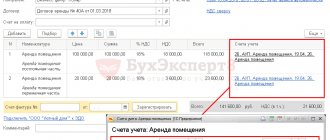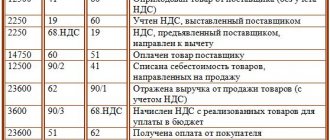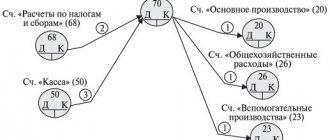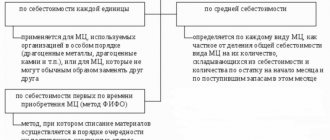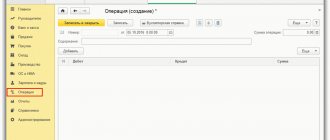Any financial and economic transaction in the activities of the company is reflected in the accounting accounts. All accounts are interconnected. The principle of their interaction is described by the double entry method. The chart of accounts itself is a list in which the number corresponds to a name that reflects the essence of the business transaction. It was approved by Order No. 94n as amended on November 8, 2010.
A product is any purchased or produced valuable item intended for subsequent sale. If an organization produces a product for internal use, it is not a product. Let's look at the basic entries for goods and services in accounting.
The goods accounting account is 41.01, usually it is maintained in both total and quantitative versions. If the company incurred additional expenses directly when purchasing the goods, these expenses are usually also taken into account in account 41.01. There is an alternative option - accounting for costs separately, on account 44.01.
Let's look at the main examples of accounting entries for goods on 41 accounting accounts.
Accounting for goods and materials
Goods and materials are often combined into one accounting group and given a general name - inventory assets, abbreviated as goods and materials.
Inventory materials in finished form intended for further sale are goods. And materials are goods and materials that are purchased for use in the manufacture of the company’s products, or for their own needs that affect the overall production process, provision of services or performance of work.
Inventory and materials are taken into account at the actual cost, which consists of the amounts of funds transferred or paid (in cash) to the supplier and other expenses associated with transportation, commission costs, etc.
What is it needed for
Let's look at 41 accounting accounts (for dummies), because the topic of accounting for goods occupies a key place in the financial and economic activities of the organization.
Here goods are meant as a set of inventory items acquired by an enterprise for the purpose of further sale (clause 2 of PBU 5/01). Inventory and materials can also be transferred to the organization by other legal entities. Account 41 in accounting - “Goods”, is used by organizations on the basis of the chart of accounts approved by Order of the Ministry of Finance No. 94n dated October 31, 2000. Account 41 reflects only those inventory items that directly belong to the institution as property rights. All inventory items that are in storage or on commission and do not belong to the enterprise are accounted for off-balance sheet (accounts 002, 004).
How goods are accepted for accounting
Goods are accepted for accounting in the same way as materials, at actual cost. For accounting purposes, account 41 and subaccounts opened to it are used. When carrying out retail trade, you also need account 42 “Trade margin”. If you keep records at accounting prices to reflect the difference between them and actual prices, then accounts 15 and 16 will be needed.
Products are sold wholesale and retail. In this case, accounting is influenced by the organization’s taxation system, and the methods enshrined in the accounting policy, and automation, or its absence at the point of sale, and the presence of intermediaries. When concluding a supply agreement, it is necessary to clearly state all the conditions that relate to prepayment, full payment and shipment, since the write-off of costs and the moment of sale of goods depend on this.
Wholesale trade can be carried out on the following terms:
- Prepayment and subsequent shipment.
- Shipment and then payment for the goods.
- Payment in foreign currency and then shipment. And vice versa.
- Sale of goods with their transportation to the buyer.
There are also many nuances in retail trade:
- Sale of goods at an automated point of sale (ATP) at sales prices in cash and non-cash.
- Sale of goods at a manual point of sale (NTP) at sales prices in cash and non-cash.
- Sale of goods at purchase prices.
Features of using account 41
All inventory items (material assets) stored in warehouses and bases of the enterprise for future sale must be taken into account. The PBU provides a special tool for this purpose - account 41 “Goods”. The accounting policy of the organization should specify the procedure for accounting for inventory items, namely the following areas:
- formation of the cost of goods - taking into account purchase costs or not;
- reflection of the resulting cost in accounting;
- accounting for trade margins.
In some cases, it becomes necessary to keep records of inventory items according to a specially developed nomenclature - this fact should also be reflected in the accounting policy of the enterprise.
Companies in different industries can use account 41, but usually these are organizations working in the catering industry. For enterprises specializing in production or industry, account 41 is needed if:
- materials, products, products purchased for resale;
- the cost of completing finished goods not included in the cost price.
Inventory items that are in custody or intended for subsequent sale under a commission agreement should not be displayed on account 41.
Example of postings for 41 accounts
The Alpha organization carries out wholesale and retail trade. The goods were shipped to Omega after receiving full payment in the amount of RUB 274,520. (VAT RUB 41,876). Three days later the goods were shipped to the buyer.
Cost of goods sold RUB 129,347. In retail, daily revenue amounted to 17,542 rubles. (VAT 2676 rub.). The sale was carried out using ATT. To account for the trade margin, account 42 was used. The amount of the margin was 6,549 rubles.
| Account Dt | Kt account | Wiring Description | Transaction amount | A document base |
| 51 | 62.02 | Money has been deposited into the bank account from Omega | 274 520 | Bank statement |
| 76.AB | 68.02 | An advance invoice has been issued | 41 876 | Outgoing invoice |
| 62.01 | 90.01.1 | Revenue from sales of goods is taken into account | 274 520 | Packing list |
| 90.02 | 68.02 | VAT charged on sales | 41 876 | Packing list |
| 90.02.1 | 41.01 | Sold goods written off | 129 347 | Packing list |
| 62.02 | 62.01 | Advance credited | 274 520 | Packing list |
| An invoice for sales has been issued | 274 520 | Invoice | ||
| 68.02 | 76.AB | VAT deduction on advance payment | 41 876 | Book of purchases |
| 50.01 | 90.01.1 | Retail revenue taken into account | 17 542 | Certificate-report of the cashier of the operator based on the retail sales report |
| 90.03 | 68.02 | VAT charged | 2676 | Certificate-report of the cashier of the operator based on the retail sales report |
| 90.02.1 | 41.11 | Write-off of goods at sales price | 17 452 | Certificate-report of the cashier of the operator based on the retail sales report |
| 90.02.1 | 42 | Accounting for mark-ups on goods | -6549 | Help for calculating the write-off of trade margins on goods sold |
Accounting by sales price
If an organization registers goods at the subsequent sale price, then it becomes necessary to use account 42. Account. “Trade margin” takes into account income from the sale of goods and VAT.
The accountant makes the following quotes with the correspondence of accounts 41 and 42:
- Dt 41 Kt 42 – reflects the markup on the goods received.
- Dt 90.2 Kt 42 - the amount of the markup was deducted when making a sale.
- Dt 41 Kt 42 – write-off of the discounted value of goods due to the previously made markup.
- Dt 91.2 Kt 41 – the difference between the markup and the discounted value is written off (in cases where the markdown exceeds the amount of the markup).
- Dt 44 Kt 41, Dt 44 Kt 42 – goods and their trade margins are written off for the needs of the enterprise.
- Dt 94 Kt 41, Dt 94 Kt 42 – the amount of shortage/damage to the goods and its trade margin are written off.
Translation of goods into materials
In production and trading organizations, goods are often transferred to the category of materials. Such a movement is documented with the TORG-13 consignment note.
Example
Alpha purchased 920 meters of cable for sale in the amount of RUB 179,412. (VAT RUB 27,383). To carry out electrical installation work, 120 meters of cable were needed, so this amount of goods was converted into materials.
| Account Dt | Kt account | Wiring Description | Transaction amount | A document base |
| 41.01 | 60.01 | Goods have arrived | 152 029 | Packing list |
| 19.03 | 60.01 | VAT included | 27 383 | Packing list |
| 68.02 | 19.03 | VAT is accepted for deduction | 27 383 | Invoice |
| 10.01 | 41.01 | Products translated into materials | 19 830 | Internal movement invoice |
Account 41. Reflection of warehouse operations in accounting
To record the receipt and movement of goods in the warehouse and its write-off, account 41 is used (sub-account 41.1 Goods in warehouses). The basis for reflecting the receipt of goods and materials at the organization's warehouse is the delivery note, according to which the supplier shipped the goods. This operation is reflected in accounting with the following entry:
Dt 41 Kt 60.
Upon receipt of goods from other contractors:
Dt 41 Kt 76.
One of the operations of warehouse accounting of goods is its internal movement. This operation is usually common in retail establishments. For example, a product received from a supplier and posted to the main warehouse (wholesale) is moved to a retail warehouse (outlet). The basis for moving goods between warehouses is an invoice certified by the signatures of the persons issuing and receiving goods and materials. If the goods are moved to an automated point of sale, then the following entry is made in accounting:
Dt 41.01 Tt 41.11.
If goods are delivered from a wholesale warehouse to a point where accounting is done manually, then this operation is carried out as follows:
Dt 41.01 Tt 41.12.
When returning goods to the main warehouse (the goods are not sold or require additional packaging), the reverse entry is reflected in the accounting:
Dt 41.11 (41.12) Kt 41.01.
All operations for the movement of goods (including internal) are recorded in the appropriate accounting card (TORG-28, MX-10).
When a product is written off from a warehouse upon its sale, an invoice is issued to the buyer, which is signed by the person who shipped the goods and the recipient. Depending on the type of goods released from the warehouse, the following entries are made in accounting:
- goods were shipped from the warehouse, finished products Dt 45.1 Kt 41.1;
- containers for shipped goods were written off from the warehouse Dt 45.2 Kt 41.1;
- write-off of the cost of goods under a commission agreement Dt 45.5 Kt 41.1.
If damage or shortage of goods is detected in the warehouse, its cost is written off to account 94:
Dt 94 Kt 41.
The basis for such a write-off is an act of the commission, according to which the fact of damage or shortage (including as a result of theft) was established. A mandatory supporting document is an inventory sheet, which records information about the discrepancy between the actual quantity of goods and the accounting quantity.
Write-off of goods from 41 accounts for the needs of the organization
An organization may need the goods it sells for general business needs. Write-offs can be made by converting goods into materials or bypassing this operation, based on an order.
Example situation:
The organization purchased 87 packs of paper for retail sale for a total amount of 7,905 rubles. (VAT 1206 rub.) For office needs, 5 packs were needed.
| Account Dt | Kt account | Wiring Description | Transaction amount | A document base |
| 41.01 | 60.01 | Goods have arrived | 6699 | Packing list |
| 19.03 | 60.01 | VAT included | 1206 | Packing list |
| 68.02 | 19.03 | VAT is accepted for deduction | 1206 | Invoice |
| 41.11 | 41.01 | The goods were moved from the wholesale warehouse to the retail warehouse | 6699 | Invoice for internal movement (TORG-13) |
| 41.11 | 42 | Take into account the trade margin | 2609 | Invoice for internal movement (TORG-13) |
| 26 | 41.11 | Products written off for office needs | 604 | Request-invoice |
| 26 | 42 | Adjusting the cost of goods for office needs | 219 | Accounting information |
An example of accounting for sales price at an enterprise
Let’s assume that a fictitious company has carried out the following business transactions: goods worth 12,000 rubles have been purchased (including VAT of 2,000 rubles). The established markup rate is 30%. The accountant makes the following calculations:
- (12,000 – 2000) × 30% = 3000 rub. – the amount of markup on the product has been identified.
- (10,000 + 3000) × 18% = 2340 rub. – VAT is calculated for the sale price at a rate of 18%.
- 3000 + 2340 = 5340 rub. – the total amount of the markup on the product is calculated, including VAT.
The process is described by the following accounting entries:
Quotations at the enterprise when accounting for goods at sales cost
| Dt | CT | Amount, rub. | Characteristics of the operation |
| 41 | 60 | 10 000 | the goods are registered and accepted into the warehouse excluding VAT |
| 19 | 60 | 2 000 | VAT is deducted from the amount of purchased goods |
| 68 | 19 | 2 000 | VAT deduction completed |
| 60 | 51 | 12 000 | the debt to the supplier was repaid from the bank account |
| 41 | 42 | 5 340 | recognized markup on goods |
| 90.2 | 41 | 15 340 | the amount of goods for sale is written off |
| 90.2 | 42 | 5 340 | the markup amount is deducted from the cost of the goods |
| 62 | 90.1 | 15 340 | revenue from the sale of goods is recognized |
| 90.3 | 68 | 2 340 | VAT calculation on goods sold |
| 51 | 62 | 15 340 | the buyer repaid the receivables for the goods |
Expenses for transport and other services incurred during the delivery of goods from the supplier are credited to account 44 (Dt 44 Kt 60). If at the end of the reporting period the goods paid for by the company have still not been delivered, the accountant posts Dt 41 Kt 60, while posting to the warehouse is not carried out. When the goods are at the disposal of the company, the amount of VAT is deducted and the cost of the goods is included in the debit of the account. 60.
Typical operations for accounting for goods
- Reflection of additional costs for goods - for example, delivery or storage of goods.
- Return of goods from the buyer - return receipt of goods from the buyer.
- Write-off of goods is a reflection in accounting of damage or loss of goods.
Organization of accounting of goods in the warehouse
A warehouse is a room that is specifically designed for storing materials and supplies. An organization's warehouse can be either an integral part of it or act as an independent structural unit. In the first case, the warehouse is used exclusively as one of the stages of the production process; in the second case, the warehouse can act as a separate object (for example, a retail outlet from which goods are sold).
| ★ Best-selling book “Accounting from scratch” for dummies (understand how to do accounting in 72 hours) > 8,000 books purchased |
| ★ Best-selling book “Accounting from scratch” for dummies (understand how to do accounting in 72 hours) > 8,000 books purchased |
The technological process in a warehouse consists of several stages:
- acceptance of goods and materials (including preliminary preparation of goods for acceptance).
- placing goods in warehouses and ensuring their storage.
- preparing goods for release from the warehouse and its subsequent release.
Warehouse accounting at an enterprise can be organized using the varietal or batch method. In the first case, each type of product in the warehouse is accounted for separately. The basis for accounting for goods is a quantitative and cost accounting card (form TORG-28), which is drawn up when goods and materials arrive at the warehouse. With the varietal method, it is permissible to record several goods (for example, similar in price) in one TORG-28 card.
If an organization uses the batch method to record inventory in a warehouse, then the arrival and movement of goods is reflected by batch. The basis document for these operations is the batch list (form MX-10), which is drawn up when a batch of goods arrives at the warehouse and is filled in as it is written off.
Categories for articles on product accounting:
- Accounting for goods in accounting: postings, examples, laws
- Revaluation of goods in accounting
- Movement of goods through warehouses: postings, rules, examples
- Resale of goods between the commission agent and the principal in accounting
- Reflection of goods in storage in accounting entries
- Expenses for selling goods - postings and examples
- Examples of warehouse postings
- Accounting entries for the transfer of goods free of charge
- Accounting entries for payment for goods and services
- Accounting for goods in transit
- Consignment goods: the relationship between the consignor and the commission agent
- Carrying out an inventory: receipt of surpluses and write-off of shortages
- How does the shipment of goods occur from an accounting point of view?
- Postings for the purchase of goods and services
- Postings for the sale of goods and services
- Returning goods to the supplier: reasons, postings, examples
- Postings for receipt of goods to the warehouse
- How to reflect the return of goods from a buyer in accounting
- Write-off of goods in case of shortage or damage in accounting entries
- Postings according to additional costs for delivery of goods
A short video on how to reflect the sale of a product in 1C 8.3:
Enterprise example
You can more clearly trace the sequence of accounting operations by considering a specific case.
We have the following initial data: the company acquired borrowed funds in the amount of 480,000 monetary units (hereinafter referred to as monetary units). All money was spent on the purchase of goods (of which tax is 80,000 units). During the use of the loan, the borrower bank accrued interest in the amount of CU 60,000. The company's accounting policies govern the accounting of interest in the operating expenses account. The entire batch of goods was sold for CU720,000 units. (of which tax is 120,000 units). The procedure for conducting quotes by the accounting department
| Dt | CT | Amount, rub. | Characteristics of the operation |
| 51 | 66 | 480 000 | the loan amount is transferred to the company's bank account |
| 41 | 60 | 400 000 | goods are capitalized (excluding tax) |
| 19 | 60 | 80 000 | VAT has been deducted from the cost of purchased goods |
| 68 | 19 | 80 000 | VAT is transferred to the state budget |
| 91.2 | 66 | 60 000 | The bank charges interest on the loan |
| 90.2 | 41 | 400 000 | the selling price of the item has been written off |
| 62 | 90.1 | 720 000 | revenue from the sale of goods is recognized |
| 90.3 | 68 | 120 000 | tax charged on goods sold |
| 51 | 62 | 720 000 | payment received from the buyer |
A clear example of the process of posting goods at an enterprise clarifies the situation, and there is no need to choose whether to open account 41 in accounting with or without VAT. Regardless of the value at which the goods are recorded, VAT is not taken into account on account 41.
Definition of goods and their types
A product is an object of civil rights or a product of an enterprise’s activity (including a service, work or financial service) intended for sale, exchange or putting into circulation.
According to the Tax Code, a commodity is any property intended for sale. In a broad sense, a product is a tangible or intangible property sold on the market. A commodity in the narrow sense is understood as a product of labor.
For example, a product of mental and physical labor, the result of a service, that is, everything that has a consumer value and its owner can exchange it for another product or money.
All products can be divided into 2 large groups:
- Material-material, having physical properties;
- Intangible – services, consultations. Intangible goods are specific and very diverse:
